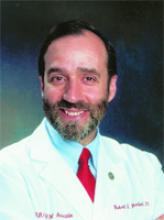Every practicing physician has vivid memories of the “high anxiety” triggered by the numerous examinations required to become a certified obstetrician-gynecologist in the United States.
Currently, at least 5 high-stakes hurdles must be cleared: the 3 parts of the United States Medical Licensing Examination, cosponsored by the National Board of Medical Examiners (NBME) and the Federation of State Medical Boards (FSMB), and the written and oral examinations sponsored by the American Board of Obstetrics and Gynecology.
Starting in 2004, the NBME and FSMB will add yet another obstacle to the licensing process: a new clinical-skills examination.
Assessing patient interaction and documentation
In this new 1-day test, third- and fourth-year medical students will examine 10 to 12 actors who have been trained by the NBME to portray patients with medical problems commonly seen in ambulatory practice. Each encounter involves a 15-minute session between the student and the standardized “patient.”
Candidates are expected to
- gather information related to the patient’s chief complaint,
- perform a focused physical examination,
- develop a treatment plan, and
- answer any questions the patient may have regarding his or her condition.
Following this session, the student has 10 minutes to prepare a note that documents his or her findings. Meanwhile, the standardized patient will rate the student’s performance. A physician examiner will then determine a grade based on the quality of both the student-patient interaction and the documentation.
This examination has purportedly been validated to rate the student’s ability to gather information during the history and physical examination, as well as to communicate findings to the patient. However, many medical faculty suspect that most such tests fail to identify the qualities necessary to be what patients consider a “good doctor.”
Issues of contention
This isn’t the first time such an exam has been part of the licensing process. From 1916 to 1964, the NBME required all candidates for medical licensing in the United States to pass a standardized clinical examination. As some senior clinicians may recall, however, not every exam tested “standardized” clinical skills. For example, there are tales of candidates being asked to perform an ophthalmologic exam on a standardized patient—but not being told that the patient had a glass eye. Ultimately this testing was halted due to too many students and not enough examination sites, a shortage of examiners, and the difficulty of standardizing the test “patients.”
Not surprisingly, medical students are less than enthusiastic about the prospect of an additional high-stakes examination—and they make some valid arguments. Many contend that it is the medical schools’ responsibility to prove that their graduates are competent to perform routine history and physical examinations.
Beyond the potential redundancy of the examination, the students also cite the additional costs—approximately $975 per examination. And this does not include travel expenses.
To both enhance the validity of the test and minimize its cost, the exam will only be administered at approximately 5 state-of-the-art, centralized testing facilities. (Sites already chosen include Philadelphia and Atlanta.) Since the average medical student graduates approximately $99,000 in debt, this point is not without merit.
In addition, medical students note that the examination’s validity has not been documented by research published in peer-reviewed journals.
A better use of resources
Despite these protests, both the NBME and the FSMB believe this additional checkpoint is required to ensure that students have the requisite clinical skills before they are licensed to practice medicine.
Still, it is not clear whether another high-stakes exam is really needed for medical students aspiring to become physicians. These resources would probably be better spent improving the ways in which medical schools develop and document the clinical skills of their graduates.


